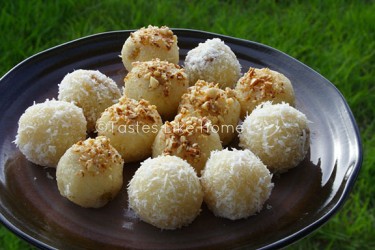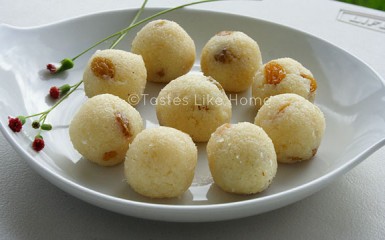Hi Everyone,
While Phagwah is all about savoury snacking, Diwali is about sweet meats – sweet snacks and desserts. This sweet-laden festival brings out the sugar lovers in full force with offerings of Gulab Jamoon, Burfi/Barfi, Sweet Rice (Kheer), Peera and a host of other snacks including Laddoo.
Laddoo/Laddu is a ball-shaped sweet that is very popular in India. Given the influence on our cuisine, Laddoo is also made in the Caribbean. It is one of those sweets that is especially associated with celebrations – birth, weddings, religious festivals and other special occasions. It also forms part of the prasad offerings at temples. Laddoo can be made with a variety of ingredients but the most popular are those made with chickpea flour, wheat semolina and coconut. You can even make Laddoo with sago – toast the sago and then grind it into a powder. Of course these days it is easy to get already ground sago.
I’ve said this on more than one occasion in this space. One of the things I greatly miss about living in Guyana is the community and societal celebrations of the religious feasts and festivals we have. Regardless of what is happening in the country, and even if it is at the last minute, everyone gets involved in some way, even as a spectator. I have Hindus, Muslims, Catholics and Mormons in my family, immediate and extended. Therefore, when these occasions came around every-man-jack was on board and set to work preparing for the feast. What I especially liked is how much I got to learn on those occasions. The older folks talked about how things were when they were growing up, the traditions and customs their parents followed. They swapped stories, teased each other, made jokes and so on. It was particularly interesting to see my parents, aunts, uncles (blood related and others) in this light. It was a youthful, playful side to them, one that as a child growing up, I rarely got to see, except when they were around each other. As I reflect on that, I think as children we forget that our parents were once young and youthful. We think that they were always so very grown up and serious. I miss my family. I miss Guyana.
 Anyway, getting back to the Laddoo. One of the things about making many Indian sweets is that it is time consuming. Like so many things, it is all about technique and perfection. The confection or dessert being made almost always starts with the long, slow cooking of milk to thicken it to the desired consistency and then working from there. You stand for hours at the stove with a pot of milk on low heat, stirring uninterrupted to ensure that the milk does not scorch (catch at the bottom of the pot) or come to a boil. If (heaven forbid) it does you can continue with the making of the sweet meat. Just understand that everyone will be told that you made that batch and be prepared for the teasing and tantalizing that will ensue. Know also that another batch will be made, perfect this time, either by you if there is time, if not by someone else who is more proficient at making it.
Anyway, getting back to the Laddoo. One of the things about making many Indian sweets is that it is time consuming. Like so many things, it is all about technique and perfection. The confection or dessert being made almost always starts with the long, slow cooking of milk to thicken it to the desired consistency and then working from there. You stand for hours at the stove with a pot of milk on low heat, stirring uninterrupted to ensure that the milk does not scorch (catch at the bottom of the pot) or come to a boil. If (heaven forbid) it does you can continue with the making of the sweet meat. Just understand that everyone will be told that you made that batch and be prepared for the teasing and tantalizing that will ensue. Know also that another batch will be made, perfect this time, either by you if there is time, if not by someone else who is more proficient at making it.
If you want to cheat, (I use this word lightly for I do not believe the act to be cheating but rather to be assisting) especially when you are pressed for time, the use of condensed milk can make your life a whole lot easier. It will cut down the cooking time by half in many cases. You have to be careful who you are making the things to serve to though. The aficionados will know right off the bat whether you used condensed milk or not. Let’s pray that they don’t frown on it and start off by saying, “Dem young gal dese days…” (LOL).
If you are celebrating Diwali and looking for a sweetmeat to add to your offerings that won’t take a lot of time, then give this quick version of Coconut Laddoo a try. Or if you’re just looking for ideas for sweets to make generally, I think you’ll like this.
Coconut Laddoo
Yield: 20 – 22

I made these Laddoo with fresh coconut but if you like, you can make it with un-sweetened desiccated coconut.
INGREDIENTS
2 teaspoons ghee (or vegetable oil)
1 dozen raw almonds, finely chopped (optional)
4 cups grated coconut (fresh)
1 x 14 oz. can condensed milk
¼ teaspoon ground cardamom (elaichi)
¼ cup raisins (optional)
DIRECTIONS
Heat 1-teaspoon ghee (or oil if you are using) in a small frying pan and toast the nuts until fragrant and golden. Set aside to cool in a bowl or small plate.
Add the coconut to a dry heavy bottomed pan or pot. A karahi would do. Place on low heat and dry toast the coconut; you do not want it to get a colour just to get a little dry. Stir it around often to ensure that it does not stick to the bottom of the pan/pot. Cook for 6 – 8 minutes.
Remove about ¼ cup of the coconut and spread in an even layer in a small plate and set aside to cool.

Pour in the condensed milk into the remaining coconut in the pan and stir to mix well (still on low heat). Let the coconut and milk mixture cook until it thickens, gets pasty and comes away easily from the sides of the pan. The mixture will get stiff. Throughout the process of cooking, stir the mixture frequently to ensure that it does not scorch at the bottom.
The time for this step will vary depending on the heat, the type of pan. Also, if you are using fresh coconut, the cooking time will be longer than if using desiccated coconut; this is because of the moisture in fresh coconut.
Add in the cardamom and raisins about 2 – 3 minutes before you think the mixture will be done cooking and mix well.
Remove the mixture from the heat and let cool until you can handle, however, do not let the mixture come to room temperature before you roll the Laddoo. It must be rolled when the mixture is still very warm.
Rub a little of the remaining ghee or oil on your hands and take the mixture a bit at a time and roll into balls, make them as large or small as you like.
Now here are your options for garnishing – roll some of the Laddoo in the reserved coconut or take the Laddoo, one at a time and press into the chopped almonds, only at the top. Some you can leave as is without garnishing.
Let the Laddoo cool completely then serve or store in an airtight container in the refrigerator. When you are ready to serve them, bring up to room temperature to enjoy the full flavour and texture of the Laddoo.
NOTES
Use the Laddoo rolled in the fresh coconut garnish first as they will have a short shelf life. The others can keep in the refrigerator for up to 2 weeks. If you used desiccated coconut, it will keep longer in the refrigerator and can also be kept at room temperature in an airtight container in a cool place for 2 – 3 weeks.
When rolling the Laddoo, it should not be sticking to your hands. In other words, it can feel sticky but the mixture should not be coming off in your hands, if it is then it needs to be cooked further until it is a bit drier.
Add it back to the pan and continue to cook on low heat.
If you are rolling the Laddoo and find it to be cracking, it means that it is too dry. Add it back to the pan along with a little milk and cook to the right consistency.
I peeled the brown skin off the coconut before I grated it because I wanted a particular look for my Laddoo. However, you can grate it with the brown skin on, it will actually add more fibre the Laddoo.
Instead of working as a garnish, the almonds can be added to the mixture the same time when adding the cardamom and raisins.
You don’t have to put raisins or almonds in the Laddoo mixture if you don’t have or don’t want to.
Nuts and dried fruits of your choice can be added to the mixture.
Shubh Diwali!
Cynthia




